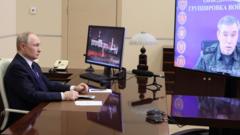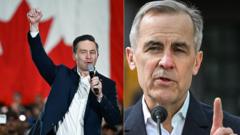On April 28, 2025, Canadian voters will choose between Prime Minister Mark Carney's Liberal Party and Pierre Poilievre's Conservative Party, with key issues revolving around economic concerns linked to U.S. tariffs and political tensions under President Trump.
Canada’s Elections: Voter Sentiment Shaped by U.S. Influence

Canada’s Elections: Voter Sentiment Shaped by U.S. Influence
As Canadians head to the polls, the looming presence of U.S. politics and President Trump's actions weigh heavily on the minds of voters.
Canadians are heading to the polls today for parliamentary elections that will determine the future leadership of their government. The contest pits the incumbent Liberal Party, led by Mark Carney, a former banker and seasoned economic policymaker, against Pierre Poilievre's Conservative Party, known for its right-leaning policies. Central to the political discourse is the influence of U.S. President Donald Trump, whose recent tariff initiatives and provocative statements regarding Canada have become focal points in the campaign.
In light of these tensions, voters are primarily preoccupied with two significant issues: the economy and the implications of U.S. foreign policy on Canada. Trump's tariffs are hurting the Canadian economy, which has already been struggling, prompting some voters to express dissatisfaction with the Liberal government's decade-long tenure. Many of these voters are expected to lean towards the Conservative Party, which is advocating for change through smaller government, tax reductions, and deregulation.
In contrast, a considerable portion of the electorate is concerned about how Canada should respond to the pressures from the U.S. This sentiment touches on both economic and broader existential concerns, especially considering Trump's overt suggestions of annexing Canada. Mark Carney's experience might resonate with voters looking for a steady hand during these turbulent times, making them favor the Liberal Party as they assess the current political landscape and the potential risks posed by the neighboring superpower. As election day unfolds, the implications of U.S. political dynamics on Canadian voter preferences will be pivotal in shaping the outcome.























